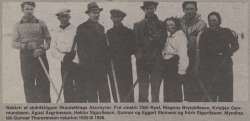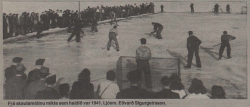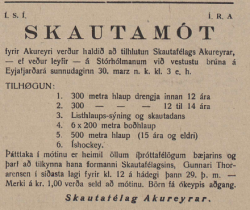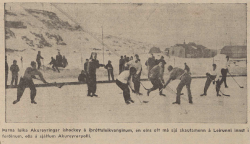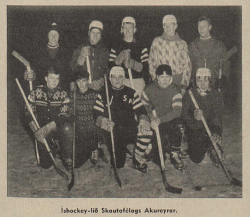Iceland: Difference between revisions
No edit summary |
No edit summary |
||
| (4 intermediate revisions by the same user not shown) | |||
| Line 13: | Line 13: | ||
|IIHF ranking = 36 | |IIHF ranking = 36 | ||
|Top league = [[Icelandic Hockey League]] | |Top league = [[Icelandic Hockey League]] | ||
|Champion = | |Champion = | ||
|}} | |}} | ||
'''Iceland''' is an island country in the Nordic region of Northern Europe. Reykjavik is the capital and largest city. | '''Iceland''' is an island country in the Nordic region of Northern Europe. Reykjavik is the capital and largest city. | ||
| Line 19: | Line 19: | ||
==Overview== | ==Overview== | ||
===National Teams=== | ===National Teams=== | ||
{{IIHFteams2|Iceland}} | |||
===Domestic Teams=== | ===Domestic Teams=== | ||
See [[:Category:Ice hockey teams in Iceland]] | See [[:Category:Ice hockey teams in Iceland]] | ||
| Line 41: | Line 40: | ||
|- | |- | ||
|[[Icelandic Hockey League Division II|Icelandic Division II]] | |[[Icelandic Hockey League Division II|Icelandic Division II]] | ||
| | | 2014 | ||
| | | 2018 | ||
| | |Defunct second-level national competition | ||
|- | |||
|[[Icelandic Cup]] | |||
|2018 | |||
|2019 | |||
|Defunct cup competition | |||
|- | |- | ||
|[[Icelandic Championship]] | |[[Icelandic Championship]] | ||
| Line 57: | Line 61: | ||
==History of hockey in Iceland== | ==History of hockey in Iceland== | ||
[[File:1935-36 Akureyrar Founders.png|thumb|250px|Some of the founders of Skautafélag Akureyrar, circa 1935-1936.]] | |||
[[File:1941 Akureyri Tournament.png|thumb|250px|An image of an ice hockey game played during the 1941 Akureyri Tournament.]] | |||
[[File:1941 Akureyri Tournament Ad.png|thumb|250px|Ad for the Akuyreyri Tournament.]] | |||
[[File:1958 Akureyri Hockey.png|thumb|250px|Hockey being played in Akureyri, from the March 21, 1958 edition of ''Tíminn''.]] | |||
[[File:1966 Skautafelag Akureyrar.png|thumb|250px|1966 Skautafelag Akureyrar]] | |||
[[File:1967 Armannson.png|thumb|200px|Jons D. Armannson, chairman of Skautafélag Akureyrar, playing goalie circa 1967.]] | |||
Second generation Icelanders (born in Canada with Icelandic parents) started playing ice hockey in Winnipeg as early as 1897. The Icelanders of Winnipeg of that time were sharply divided into two rival camps. Between 1897-1902 the two teams that had a fierce rivalry was the Icelandic Athletic Club (I.A.C.) and the Vikings. The IAC club resided in the northern parts of Winnipeg and the Vikings in the southern parts. Their rivalry was so intense that it reached into their social life as well. These two teams formed the Manitoba Icelandic League. The Vikings played in red jerseys with large white V's and white pants while the IAC had dark blue sweaters and black pants. Their home arenas were the old Brydon and McIntyre rinks. | Second generation Icelanders (born in Canada with Icelandic parents) started playing ice hockey in Winnipeg as early as 1897. The Icelanders of Winnipeg of that time were sharply divided into two rival camps. Between 1897-1902 the two teams that had a fierce rivalry was the Icelandic Athletic Club (I.A.C.) and the Vikings. The IAC club resided in the northern parts of Winnipeg and the Vikings in the southern parts. Their rivalry was so intense that it reached into their social life as well. These two teams formed the Manitoba Icelandic League. The Vikings played in red jerseys with large white V's and white pants while the IAC had dark blue sweaters and black pants. Their home arenas were the old Brydon and McIntyre rinks. | ||
The earliest IAC team had players such as Harry Sivertson in goal, Percy (Ben) Olafson at | The earliest IAC team had players such as Harry Sivertson in goal, Percy (Ben) Olafson at point and "Swanny" Swanson at cover point. As a rover they had the extremely talented "Fusi" Byron and on the forward line they had Magnus Peterson, Jack Snidal and Jack Swanson. The Vikings had the blonde Fred Olsen,who later became a member of the Montreal Victorias team that challenged for the [[Stanley Cup]] in 1903, in goal. At point there was Paul Johnston and at cover point they had robust six foot Henry Thompson. | ||
point and "Swanny" Swanson at cover point. As a rover they had the extremely talented "Fusi" Byron and on the forward line they had Magnus Peterson, Jack Snidal and Jack Swanson. The Vikings had the blonde Fred Olsen,who later became a member of the | The rover position was held by crafty Magnus (Mike) Johnson. Up front they had Skuli Hanson, Arni Anderson and the huge "Big Sam" Johnson who also played at the point. The Vikings won the championship every year between 1897-1902. After the 1902 season interest lagged and the league folded, though it would later be revived in 1905 and run until 1909. | ||
Montreal Victorias team that challenged for the [[Stanley Cup]] in 1903, in goal. At point there was Paul Johnston and at cover point they had robust six foot Henry Thompson. | |||
The rover position was held by crafty Magnus (Mike) Johnson. Up front they had Skuli Hanson, Arni Anderson and the huge "Big Sam" Johnson who also played at the point. The Vikings won the championship every year between 1897-1902. After the 1902 season | In 1909 Winnipeg was beginning to shake off its small town feelings and was rapidly blossoming into a big city. It was then that the Icelandic boys decided to bury the hatchet and combine to wage a joint "war" against the other leagues and teams in the city that were rapidly coming into being. So the [[Winnipeg Falcons]], a combination of both older clubs, were founded. It would later become one of the finest amateur clubs ever. In 1910-11 they joined the Manitoba Independent league. Their original lineup looked like this: Goal: George Johannesson, Defensemen: Connie Benson and Steve Dalman, Rover: Bill Halderson, Forwards: Ole Erickson, Allan Johannesson and Steve Finnson | ||
A couple of years later, future world champions Kurt "Konnie" Johannesson, Bobby Benson and Frank Frederickson joined the team. During the 1919-20 season the Falcons won the prestigious [[Allan Cup]] and earned the right to represent Canada at the [[1920 Summer Olympics|1920 Olympics]], held in Antwerp, Belgium. The Icelanders from Winnipeg easily won the Olympic gold. Haldor Haldorson (Harold "Slim" Halderson), Frank Frederickson, Kurt "Konnie" Johannesson, Christian "Chris" Fridfinnson, Mike Goodman and Robert "Bobby" Benson would all become heroes in Winnipeg. Frederickson, Halderson and Benson all played in the NHL. Frederickson, who is in the Hall of Fame also holds the distinction of being the first Boston Bruin to have a shot on goal and scored Boston's first ever playoff goal. Immediately after having won the Olympic gold he went to Iceland to visit the government there. | |||
American born Icelander (Buffalo) Bobby Benson, who before the Olympic tournament had played 8 games for Boston, became the first NHL'er ever to play in the Olympic games. Mike Goodman was a two time Canadian speed skating champion and was obviously tremendously fast on his skates. Other prominent second generation Icelanders were NHL'ers like Carol "Cully" Wilson and Hall of Famer Harry Oliver. | |||
Historian Jón Hjaltason wrote in the book ''Saga Skautafélags Akureyrar 1937-1997'' that young people from Akureyri were particularly interested in the success of their compatriots on the Canadian ice hockey team. When Haukur Stefánsson, raised in Canada, moved to Akureyri in 1934, he managed to convince the people of the town to stop playing bandy and start playing ice hockey instead. Gunnar Thorarensen translated the rules for ice hockey from Norwegian and when he heard about Canadian ice hockey sticks, he bought some and sold them to Akureyri's skaters. | |||
This great growth in Akureyri led to [[Skautafélag Akureyrar]] being founded on January 1, 1937. In late March 1941, the skating association held a major tournament in skating sports where, among other things, ice hockey was played. The tournament was filmed and the footage has been preserved and is stored at the Icelandic Film Museum.<ref>''Íshokkí á Íslandi - Heimildamynd um íþrótt á uppleið'', Alma Sigrún Sigurgeirsdóttir (2012).</ref> In December 1944, it was reported that interest in the sport was growing Reykjavik, and the Reykjavík Sports Club and Knattpyrnufél Valur planned to take it up. The Skating Association of Reykjavík (Skautafélag Reykjavikur) also advertised lessons in ice hockey.<ref>''Þjóðviljinn'', 1944-12-08</ref> An ice hockey league was established within Skuatafélag Reykjavikur during the winter of 1951, and the club received sticks and other equipment needed for this game. Its chairman was Ólafur Jóhannesson, and the coach E. Mikson.<ref>''Morgunblaðið'', 1951-12-09</ref> | |||
The first ice hockey | In 1955 two teams in the Skautafélag Akureyrar organization competed against one another - Útbæing and Innbæing. They played to a 3-3 (also reported as 2-2) tie on January 31, with the former team later winning 6-3 on February 20. Björn Baldursson refereed both games.<ref>''Árbók íþróttamanna - 1955-1956 (01.12.1956)''</ref><ref>''Laugardagsblaðið'', 1955-02-19</ref> The first Akureyri ice hockey tournament was held in the fall of 1958.<ref>[https://www.sasport.is/is/felagid/um-felagid Skautafèlag Akureyrar - Um félagið]</ref> It was slated to begin on November 30.<ref>''Dagur'', 1958-10-25</ref> On February 15, 1961, it was reported that some Akureyri people were going to go to Reykjavík and play an ice hockey game with Akureyri people who stay there to study and work.<ref>''Dagur'', 1961-02-15</ref> In 1965-66, ice hockey was practiced quite a bit in Akureyri, but by a rather small group. Practices were also organized by the Youth Council of Akureyri and S.A. for juniors.<ref>''Íþróttablaðið - 1. tölublað (01.02.1967)''</ref> | ||
Organized hockey did not gain a foothold in Iceland until the 1960s. In 1967, players from Reykjavik came to Akureyri to compete with the town in ice hockey. On the occasion of this visit, Sjóvá, Akureyri, gave a magnificent cup for a town competition in ice hockey between Akureyri and Reykjavík.<ref>''Verkamaðurinn'', 1967-10-27</ref> The first [[Icelandic Championship]] (a "town" competition) was staged in 1968. [[Skautafélag Akureyrar]] and [[Skautafélag Reykjavíkur]] were the initial clubs to be formed in the country. The championship was held intermittently, and friendly games between the two sides were organized even in years where there was no championship. A "national" competition was also played in 1980 and 1982. | |||
The Icelandic Skating Association was founded in 1987, and ice hockey was given a division in the association. An independent governing body, [[Ice Hockey Iceland]], was later created. The first artificial ice rink in Iceland didn't open until 1988 in the capital of Reykjavik and a couple of years later one opened in Akureyri. The first indoor rink opened in Reykjavik in 1998. In 1990, then-IIHF president [[Günther Sabetzki]] and general secretary Jan-Åke Edvinsson visited Iceland to explore the possibility of a future membership in the IIHF. Two years later Iceland joined the federation on May 6, 1992.<ref>[http://www.iihf.com/iihf-home/countries/iceland/ IIHF.com - Iceland]</ref> | The Icelandic Skating Association was founded in 1987, and ice hockey was given a division in the association. An independent governing body, [[Ice Hockey Iceland]], was later created. The first artificial ice rink in Iceland didn't open until 1988 in the capital of Reykjavik and a couple of years later one opened in Akureyri. The first indoor rink opened in Reykjavik in 1998. In 1990, then-IIHF president [[Günther Sabetzki]] and general secretary Jan-Åke Edvinsson visited Iceland to explore the possibility of a future membership in the IIHF. Two years later Iceland joined the federation on May 6, 1992.<ref>[http://www.iihf.com/iihf-home/countries/iceland/ IIHF.com - Iceland]</ref> | ||
Latest revision as of 23:01, 7 August 2024
| Iceland | |
| Continent | Europe |
| Population | 320,060 |
| Registered players | 606 |
| Referees | 25 |
| Rinks | 3 |
| National teams | Men's Women's Junior |
| National federation | Ice Hockey Iceland |
| IIHF since | May 6, 1992 |
| IIHF ranking | 36 |
| Top league | Icelandic Hockey League |
Iceland is an island country in the Nordic region of Northern Europe. Reykjavik is the capital and largest city.
Overview
National Teams
Men's · Men's-U20 · Men's-U18 · Women's · Women's-U18
Domestic Teams
See Category:Ice hockey teams in Iceland
Arenas
See Category:Arenas in Iceland
Competitions
| Competition | Founded | Folded | Notes |
|---|---|---|---|
| Icelandic Hockey League | 1991 | - | Top-level national competition |
| Icelandic Division II | 2014 | 2018 | Defunct second-level national competition |
| Icelandic Cup | 2018 | 2019 | Defunct cup competition |
| Icelandic Championship | 1968 | 1991 | Defunct championship |
| Icelandic Women's Hockey League | 2000 | - | National women's competition |
History of hockey in Iceland
Second generation Icelanders (born in Canada with Icelandic parents) started playing ice hockey in Winnipeg as early as 1897. The Icelanders of Winnipeg of that time were sharply divided into two rival camps. Between 1897-1902 the two teams that had a fierce rivalry was the Icelandic Athletic Club (I.A.C.) and the Vikings. The IAC club resided in the northern parts of Winnipeg and the Vikings in the southern parts. Their rivalry was so intense that it reached into their social life as well. These two teams formed the Manitoba Icelandic League. The Vikings played in red jerseys with large white V's and white pants while the IAC had dark blue sweaters and black pants. Their home arenas were the old Brydon and McIntyre rinks.
The earliest IAC team had players such as Harry Sivertson in goal, Percy (Ben) Olafson at point and "Swanny" Swanson at cover point. As a rover they had the extremely talented "Fusi" Byron and on the forward line they had Magnus Peterson, Jack Snidal and Jack Swanson. The Vikings had the blonde Fred Olsen,who later became a member of the Montreal Victorias team that challenged for the Stanley Cup in 1903, in goal. At point there was Paul Johnston and at cover point they had robust six foot Henry Thompson. The rover position was held by crafty Magnus (Mike) Johnson. Up front they had Skuli Hanson, Arni Anderson and the huge "Big Sam" Johnson who also played at the point. The Vikings won the championship every year between 1897-1902. After the 1902 season interest lagged and the league folded, though it would later be revived in 1905 and run until 1909.
In 1909 Winnipeg was beginning to shake off its small town feelings and was rapidly blossoming into a big city. It was then that the Icelandic boys decided to bury the hatchet and combine to wage a joint "war" against the other leagues and teams in the city that were rapidly coming into being. So the Winnipeg Falcons, a combination of both older clubs, were founded. It would later become one of the finest amateur clubs ever. In 1910-11 they joined the Manitoba Independent league. Their original lineup looked like this: Goal: George Johannesson, Defensemen: Connie Benson and Steve Dalman, Rover: Bill Halderson, Forwards: Ole Erickson, Allan Johannesson and Steve Finnson
A couple of years later, future world champions Kurt "Konnie" Johannesson, Bobby Benson and Frank Frederickson joined the team. During the 1919-20 season the Falcons won the prestigious Allan Cup and earned the right to represent Canada at the 1920 Olympics, held in Antwerp, Belgium. The Icelanders from Winnipeg easily won the Olympic gold. Haldor Haldorson (Harold "Slim" Halderson), Frank Frederickson, Kurt "Konnie" Johannesson, Christian "Chris" Fridfinnson, Mike Goodman and Robert "Bobby" Benson would all become heroes in Winnipeg. Frederickson, Halderson and Benson all played in the NHL. Frederickson, who is in the Hall of Fame also holds the distinction of being the first Boston Bruin to have a shot on goal and scored Boston's first ever playoff goal. Immediately after having won the Olympic gold he went to Iceland to visit the government there.
American born Icelander (Buffalo) Bobby Benson, who before the Olympic tournament had played 8 games for Boston, became the first NHL'er ever to play in the Olympic games. Mike Goodman was a two time Canadian speed skating champion and was obviously tremendously fast on his skates. Other prominent second generation Icelanders were NHL'ers like Carol "Cully" Wilson and Hall of Famer Harry Oliver.
Historian Jón Hjaltason wrote in the book Saga Skautafélags Akureyrar 1937-1997 that young people from Akureyri were particularly interested in the success of their compatriots on the Canadian ice hockey team. When Haukur Stefánsson, raised in Canada, moved to Akureyri in 1934, he managed to convince the people of the town to stop playing bandy and start playing ice hockey instead. Gunnar Thorarensen translated the rules for ice hockey from Norwegian and when he heard about Canadian ice hockey sticks, he bought some and sold them to Akureyri's skaters.
This great growth in Akureyri led to Skautafélag Akureyrar being founded on January 1, 1937. In late March 1941, the skating association held a major tournament in skating sports where, among other things, ice hockey was played. The tournament was filmed and the footage has been preserved and is stored at the Icelandic Film Museum.[1] In December 1944, it was reported that interest in the sport was growing Reykjavik, and the Reykjavík Sports Club and Knattpyrnufél Valur planned to take it up. The Skating Association of Reykjavík (Skautafélag Reykjavikur) also advertised lessons in ice hockey.[2] An ice hockey league was established within Skuatafélag Reykjavikur during the winter of 1951, and the club received sticks and other equipment needed for this game. Its chairman was Ólafur Jóhannesson, and the coach E. Mikson.[3]
In 1955 two teams in the Skautafélag Akureyrar organization competed against one another - Útbæing and Innbæing. They played to a 3-3 (also reported as 2-2) tie on January 31, with the former team later winning 6-3 on February 20. Björn Baldursson refereed both games.[4][5] The first Akureyri ice hockey tournament was held in the fall of 1958.[6] It was slated to begin on November 30.[7] On February 15, 1961, it was reported that some Akureyri people were going to go to Reykjavík and play an ice hockey game with Akureyri people who stay there to study and work.[8] In 1965-66, ice hockey was practiced quite a bit in Akureyri, but by a rather small group. Practices were also organized by the Youth Council of Akureyri and S.A. for juniors.[9]
Organized hockey did not gain a foothold in Iceland until the 1960s. In 1967, players from Reykjavik came to Akureyri to compete with the town in ice hockey. On the occasion of this visit, Sjóvá, Akureyri, gave a magnificent cup for a town competition in ice hockey between Akureyri and Reykjavík.[10] The first Icelandic Championship (a "town" competition) was staged in 1968. Skautafélag Akureyrar and Skautafélag Reykjavíkur were the initial clubs to be formed in the country. The championship was held intermittently, and friendly games between the two sides were organized even in years where there was no championship. A "national" competition was also played in 1980 and 1982.
The Icelandic Skating Association was founded in 1987, and ice hockey was given a division in the association. An independent governing body, Ice Hockey Iceland, was later created. The first artificial ice rink in Iceland didn't open until 1988 in the capital of Reykjavik and a couple of years later one opened in Akureyri. The first indoor rink opened in Reykjavik in 1998. In 1990, then-IIHF president Günther Sabetzki and general secretary Jan-Åke Edvinsson visited Iceland to explore the possibility of a future membership in the IIHF. Two years later Iceland joined the federation on May 6, 1992.[11]
The same year Sabetzki visited Iceland, the country also received a visit from Swedish coaches to help instruct the players. It wasn't the first time that foreign coaches visited Iceland though - it had previously occurred in 1980 as well. In the summer of 1992, eight Icelandic juniors traveled to Sweden to attend a hockey camp there.
The Icelandic Hockey League was founded for the 1991-92 season with three teams participating, Skautafélag Akureyrar, Skautafélag Reykjavikar and Ísknattleiksfélagið Björninn. In the early 1990s five foreigners were allowed on each team. A lot of the imports have been Americans picked from the military bases around Iceland. Many of the Russian imports came from the Russian Embassy and the Finnish imports were guys who worked there. The league has been dominated by the two Skautafélag teams - Akureyrar has won 18 titles and Reykjavikur has claimed five.
The best Icelandic player of all time is Heidar Ingi Ágústsson. He won the scoring championship in Iceland several times. Some other top Icelandic players have been: Sigurdur Svein Sigurdsson, Sigurgeir Haraldsson, Àugúst Ásgrimsson, Eggert Hannesson, Runar Runarsson, Sigurdur Sveinbjarnarson, Ingvar Jónsson, and Emil Alengaard. Áugúst Ásgrimsson became the first Icelandic trained player to play abroad when he skated for the Danish Division 1 team Århus IK during the 1997-98 season.
Some top imports in the Icelandic League have included: Clark McCormick, Allan Johnson (USA), Jukka Huttonen, Pekka Santanen, Jouni Tormanen, Timo Lehtinen (Finland) and Nikolai Nefedov (Russia). Santanen and Lehtinen both played in the Finnish Liiga and Nefedov once played in the Soviet Championship League.
The men's national team made its debut at the World Championships in 1999, playing in the D Pool.[12] They won the Division III (the former D Pool) tournament in 2004 and 2006, and have played at the Division II level since 2007.
The women's national team first participated in the IIHF World Women's Championships in 2005. They won the Division IV tournament in 2008, and have played at the Division IIB level since 2012.
The junior national team became the first national hockey team from Iceland to appear on the international scene when it played in the 1997 IIHF European U18 Championship D Pool. The U18 team again played in the tournament the following year. In 1999, Iceland made its debut in Pool D of the IIHF World U20 Championship. Their best finish was fifth in Division II in 2003 and 2007.
Credits
Special thanks to Patrick H. for supplying information on this country.
References
- ↑ Íshokkí á Íslandi - Heimildamynd um íþrótt á uppleið, Alma Sigrún Sigurgeirsdóttir (2012).
- ↑ Þjóðviljinn, 1944-12-08
- ↑ Morgunblaðið, 1951-12-09
- ↑ Árbók íþróttamanna - 1955-1956 (01.12.1956)
- ↑ Laugardagsblaðið, 1955-02-19
- ↑ Skautafèlag Akureyrar - Um félagið
- ↑ Dagur, 1958-10-25
- ↑ Dagur, 1961-02-15
- ↑ Íþróttablaðið - 1. tölublað (01.02.1967)
- ↑ Verkamaðurinn, 1967-10-27
- ↑ IIHF.com - Iceland
- ↑ National Teams of Ice Hockey - Iceland

